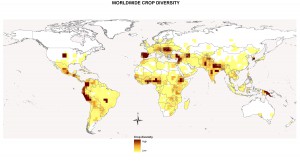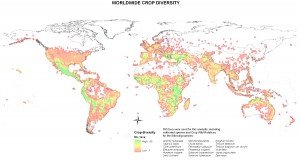- Supersizing crops.
- Using tree rings to study past Asian droughts. I guess it’s just me, but I find this much more intersting than the thought of tinkering with the Calvin-Benson cycle.
- The mother of all soil data sites.
- That ancient Egyptian aphrodisiac: brassica or lettuce?
- The Sheep is Life Celebration is coming. Wish I was going.
Nibbles: Heirloom store, Leaf miners, Mongolian drought, GPS, Coca, Ag origins, Aquaculture, Lice, Bud break in US, IFAD livestock, biofuels, Pig history
- “Housed in the towering old 1926 Sonoma County Bank, it’s hard to miss the Seed Bank.” And who would want to anyway.
- Of apples, leaf miners and bacteria. Great story.
- Best synthesis and analysis of the Mongolian dzud story so far.
- Visualize your GPS data! Not agrobiodiversity, I know, but I don’t have another blog.
- Coca myths debunked. Sniff sniff.
- “Crop domestication and the first plant breeders” book charpter online.
- Rebranding Asian carp. Hard row to hoe. Thanks, Don.
- 190,000 year old clothes had lice. 190,000 year old humans had clothes?
- More citizen science stuff, this one on effect of climate change on plant phenology in the US.
- IFAD publishes bunch of livestock-related papers. ILRI, are you listening?
- “It’s 36 percent more efficient to grow grain for food than for fuel.” Good to have a number.
- Boffins do their aDNA thing on Chinese pigs, find continuity, multiple domestication, sweet and sour sauce recipe.
- Soil Association begs to differ on that whole
UKworld-needs-to-double-food-production thing.
Nibbles: Food Security, GIS, Neoliberalism, Herbaria
- Food security? Can you say Eyjafjallajökull? Well, no, neither can I. But I know a man who can.
- Got something worth saying on GIS in Africa?
- From government intervention to the free market and back again. Neat trick if you can do it.
- Restoring Kabul’s herbarium “will vastly improve Afghan research capacity”.
An early look at an atlas of agrobiodiversity
On reading about the Atlas of Global Conservation here a few days ago, Nora Castaneda of Bioversity International’s Regional Office for the Americas sent me some of her own forays in that area, which are focused on plant species of agricultural interest. They’re still works in progress, and unpublished, ((Which is why I’m only putting up pretty low resolution images.)) but definitely worth having a quick look at. The data comes from germplasm databases (SINGER, GRIN, EURISCO) and the databases put together for the GapAnalysis project, about which we have already blogged about here.
Here’s what the distribution of numbers of accessions of varieties of the major food crops in genebanks looks like. Dark brown means lots of different accessions (not varieties, mind!).

One has to wonder what’s going on in Spain. As I say, it’s a work in progress. A certain amount of data cleaning may still be necessary, for example to identify duplicates and take them out of the equation. And when Genebank Database Hell allows it should even be possible to take into account morphological and genetic diversity.
Anyway, here’s the distribution of richness of wild relative and landrace accessions of a number of major crops. Green means lots of species and landraces.

When finished, I think these maps will make a great complement to the Nature Conservancy’s Atlas. But would the biodiversity community be interested?
An Atlas of Global Conservation goes (partially) online
The Nature Conservancy is publishing an Atlas of Global Conservation . ((Hoekstra, J. M., J. L. Molnar, M. Jennings, C. Revenga, M. D. Spalding, T. M. Boucher, J. C. Robertson, T. J. Heibel, with K. Ellison. 2010. The Atlas of Global Conservation: Changes, Challenges, and Opportunities to Make a Difference. Ed. J. L. Molnar. Berkeley: University of California Press.)) Some of the maps are online, though not the one below, which I got from a slideshow over at the Washington Post accompanying an article on the atlas.
Why not, though? Surely, if someone is really going to buy the hardcopy version, they are not going to be put off by the fact that all the maps are on the internet. I left a comment to that effect on the Conservancy’s Facebook post announcing the atlas, and they very kindly got back to me saying that more maps will indeed eventually be made available online.
What’s that you say? Any agriculture? A map of centres of crop diversity to go with the above? The list of data sources is not encouraging. But I could be wrong. I’ll keep you posted.
